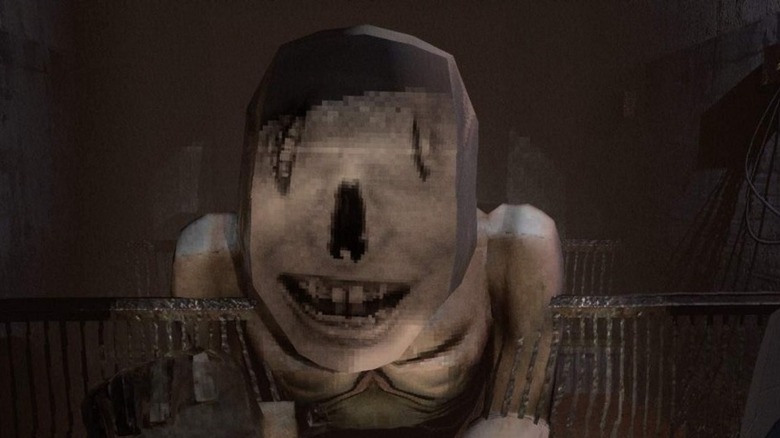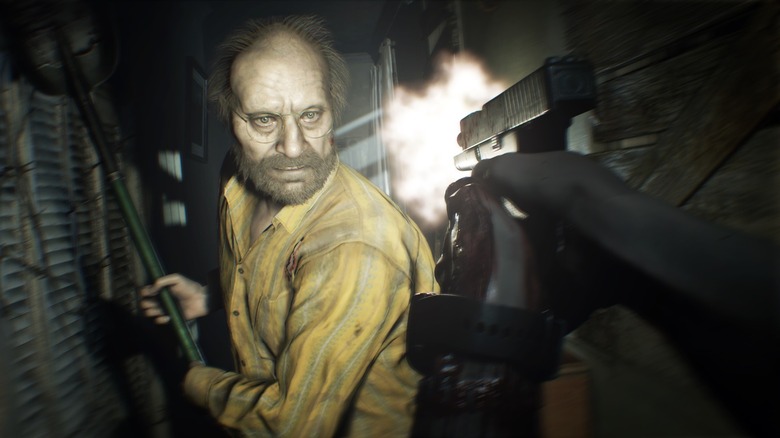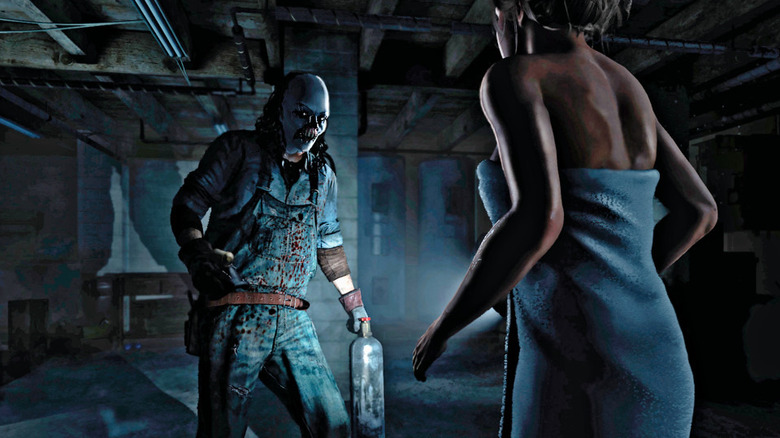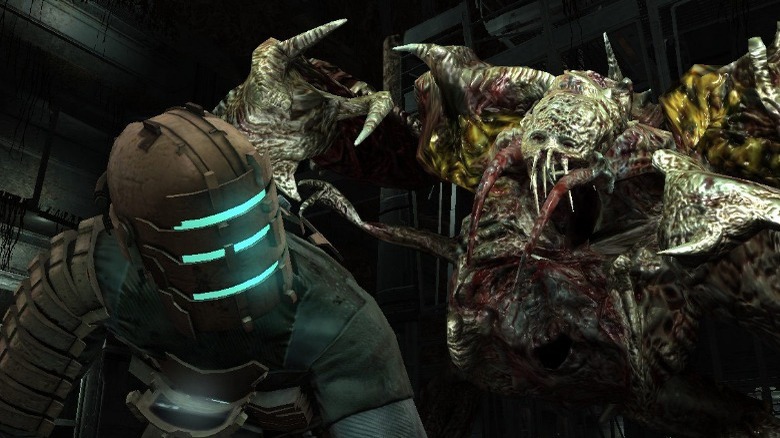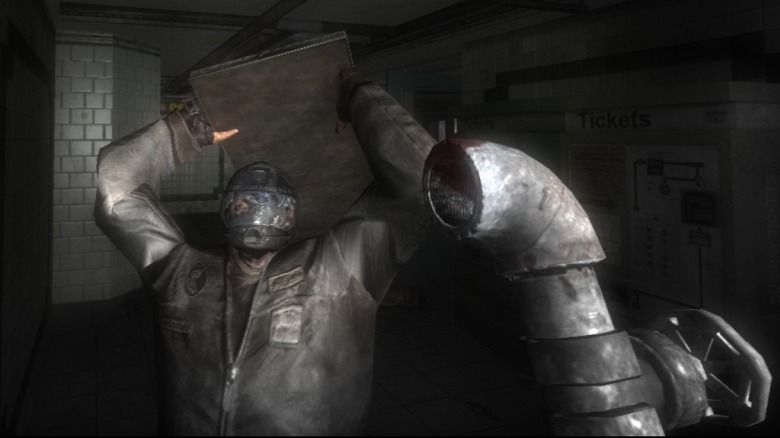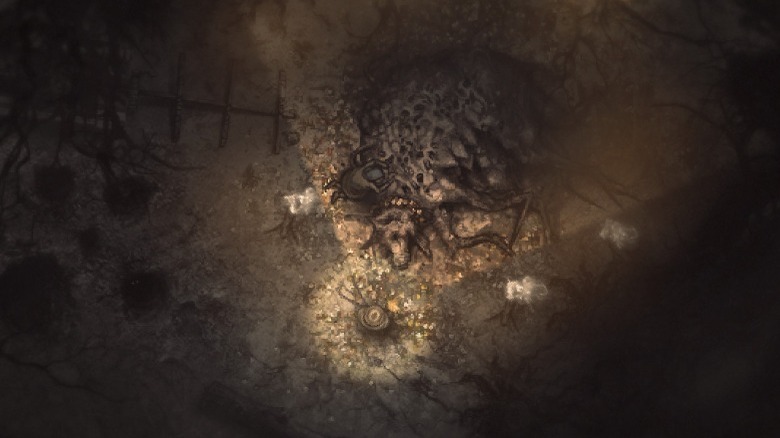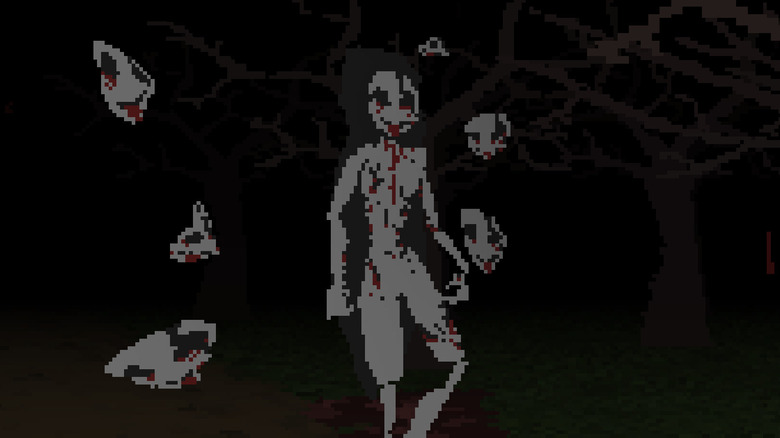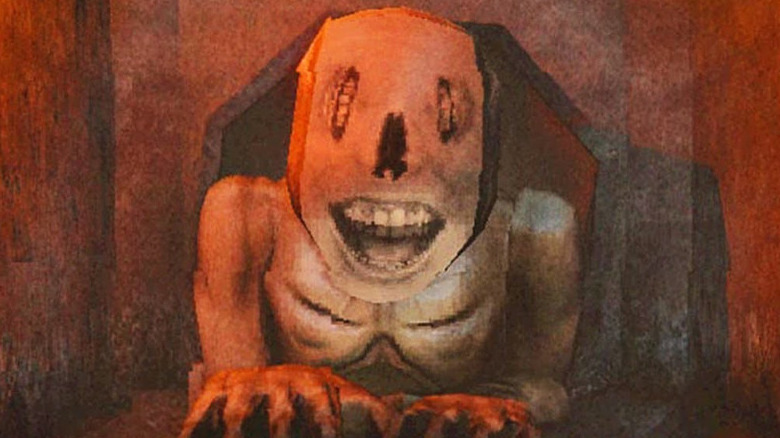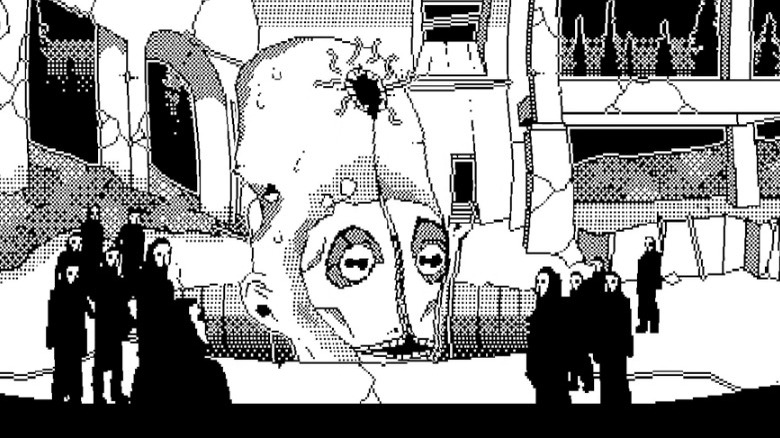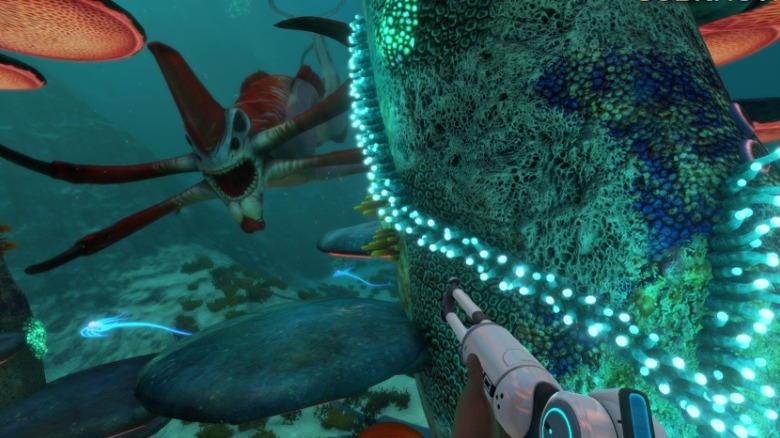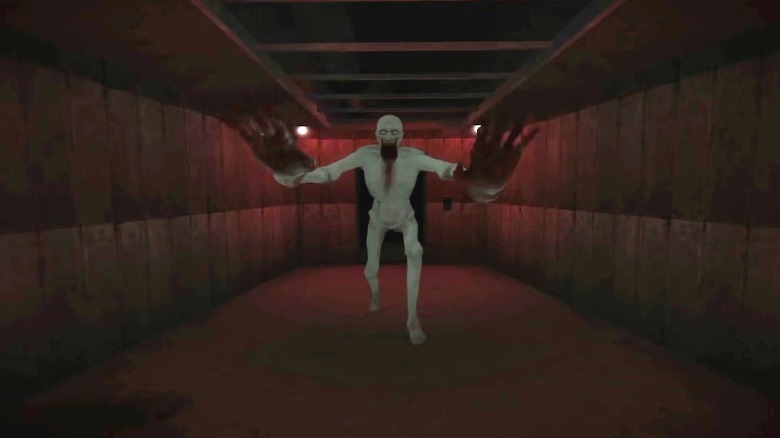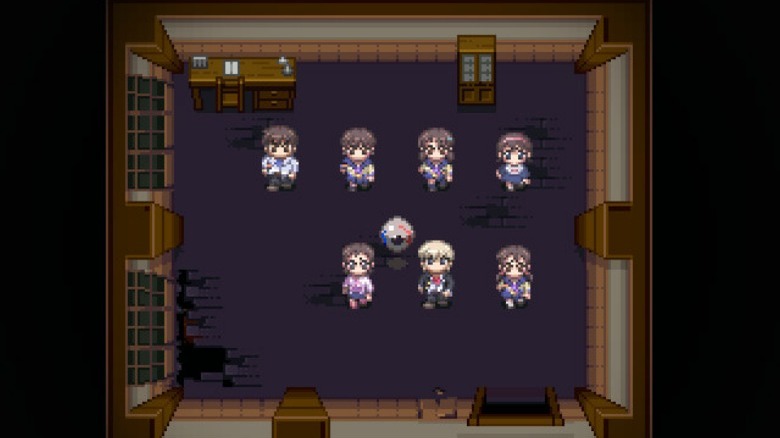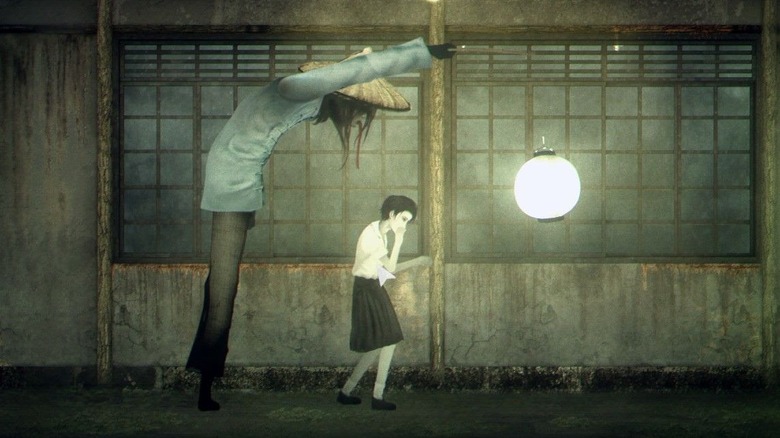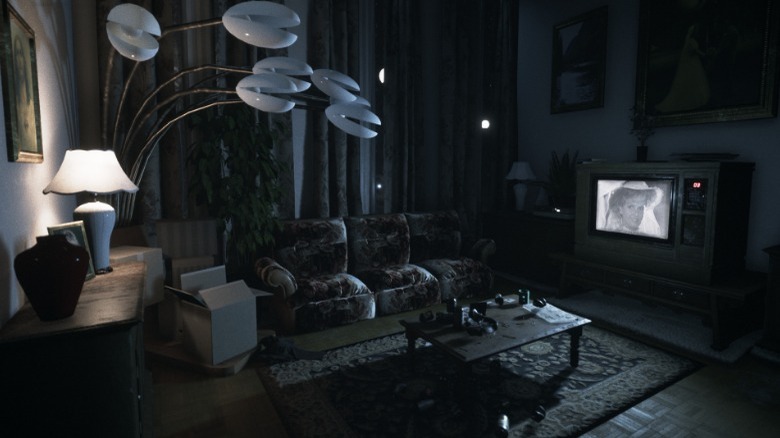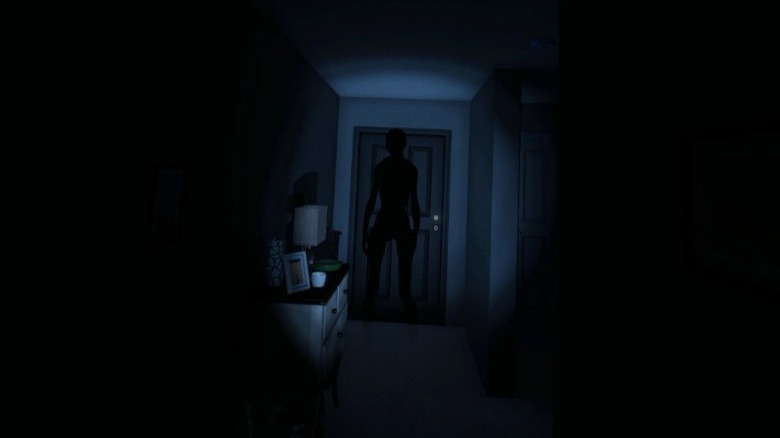Terrifying Games We Still Haven't Recovered From
There is a certain set of gamer that simply enjoys being scared; the rush of adrenaline that comes from an encounter with the unexpected or the thrill of a new and frightening challenge. That's why franchises like "Resident Evil" and "Silent Hill" have continued to grab the attention of unsuspecting players. Whether it's a sense of intense claustrophobia or the sheer panic that comes from staring down a horde of the undead, the horror genre is full of scares both psychological and physical.
Because of this, some players have discovered that there are some games that should never be played alone. But even when bringing a companion along for the ride, a few games stand out as singular experiences. Some titles get under your skin and stay there, leaving a mark that never fades with time. Plenty of horror games become less intimidating upon repeated playthroughs, but a select few are so terrifying that it's hard to shake them off, even well after you've set down your controller.
Resident Evil 7
The "Resident Evil" franchise started with a simple premise: shooting zombies, giant spiders, and other abominations against nature in cramped mansion hallways and the evil laboratory underneath. However, somewhere along the line, the developers lost the plot and replaced claustrophobia with quick-time events. While this didn't hurt "Resident Evil 4," fans were less than impressed come "Resident Evil 6" (via Den of Geek). So for the next entry, Capcom decided to put the "resident" back in "Resident Evil," as well as try a few new tricks. The result reinvigorated the franchise.
Unlike other "Resident Evil" games, "Resident Evil 7" gives players a front-row seat to the body horror. Audiences still have to creep through restrictive hallways and solve puzzles to open doors, but this time they do so from a first-person perspective that lets the game's grotesque monsters really get in player faces — and try to bite them off.
If moldy monsters aren't enough for players, they also have to constantly be on guard for the immortal Baker family. Each member has their unique brand of horror and insanity (e.g., Jack goes full grindhouse axe murderer, while Marguerite tortures entomophobes), and as the game goes on, they distort into more dangerous and deranged forms. No matter their shape, the Bakers pose a constant threat. They can pop up anywhere, and it doesn't matter how many bullets players pump into them since they will get up in a matter of seconds.
"Resident Evil 7" scared audiences so well, Capcom made "Resident Evil Village" less frightening.
Until Dawn
Many horror games draw inspiration from horror and slasher films. "Dead Rising," for instance, clearly stole a page from "Dawn of the Dead" by taking place in a shopping mall — and was sued for it (per GameSpot). Yet how many horror games actually feel like controllable slasher films? Not many, but "Until Dawn" is certainly the best in this small crowd.
"Until Dawn" has a premise that should ring familiar to slasher veterans: Eight teenagers visit a secluded cabin in the woods to vacation but instead need to survive mysterious forces that want them dead. The game unfolds like a slasher film, but audiences can decide (or at the very least influence) who lives and dies. Think "Choose Your Own Adventure" books with quick-time events and a Hollywood cast.
While much of the game's tension comes from atmosphere and trying to keep characters alive — and failure coming in the form of brutal death scenes — "Until Dawn" also tries to scare players on an individual level. Every now and then, the game asks users what scares them the most, and their answers are inserted into sequences that personalize the player's experiences.
While "Until Dawn" relies on various horror tropes and cliches, they are still used effectively and will terrify most audiences, especially since several twists recontextualize earlier events. There's nothing scarier than realizing that your earlier assumptions might have cost someone their life.
Dead Space
In the world of horror games, all it takes is some cramped corridors, a tidal wave of flesh-eating zombies, and a distinct lack of ammunition to create a recipe for a stressful (i.e., fun) time. These are also overused cliches, because the combination works a little too well. A few changes to the formula can easily create novel experiences, which is why "Dead Space" still frightens audiences.
The secret to "Dead Space" and its scares can be summarized in one word: immersion. Many studios throw that word around, but "Dead Space" lives it. While the game's enemies are disturbing on a mere conceptual level (and because their twisted designs were inspired by car crash victims, according to Destructoid), players don't view them through the safety of a UI. As noted by jackfrags, everything in "Dead Space," from inventory management to narrative-crucial cutscenes, occurs diegetically and in real time. The pause menu doesn't stop the action — or monsters.
Moreover, "Dead Space" has a few other tricks up its sleeves to scare players. Instead of relying on the tired-yet-true tactic of "aim for the head," the game utilizes a novel dismemberment system that forces players to disarm enemies by, well, literally disarming them and hoping the next detached limb finally stops their macabre advance. Add in dingy halls that breed isolation, enemy spawn points that adapt to player positioning, and music that preys on the human brain's distaste for discordant tones, and "Dead Space" seemingly does everything right.
Condemned: Criminal Origins
Do you remember the old "Futurama" ending where a scientist combines the DNA of the most evil animals on Earth to splice together the most evil creature imaginable, and the punchline is it was man all along? Well, the joke works so well because it's true: humans are capable of some frighteningly evil stuff, and games like "Condemned: Criminal Origins" will gladly remind you of this.
"Condemned: Criminal Origins" is less about startling players into a sense of heightened tension and more about, as Horror Obsessive described it, providing a "slow burning atmosphere" to accentuate psychological horror. Lighting is sparse throughout the game, which synchronizes with its grimy hallways to keep players on their toes. It also helps that enemies wait behind almost every corner, so even when the atmosphere fails to scare, lurking threats to the protagonist will.
While twisted enemies lie in wait, ready to pounce, "Condemned: Criminal Origins" keeps the jumpscares to a minimum. Most frights come from the levels and from dissecting crime scenes, but when the game does actually try to scare players, it succeeds by building on preexisting tension and spacing the scares out so they don't blur together. There's a reason why players still remember the terrifying hall of mannequins.
"Condemned: Criminal Origins" demonstrates that in horror, less is more. Once the game's brand of psychological horror claws its way into players' heads, there's no removing it.
Darkwood
Many horror games (and movies for that matter) like to scare audiences with terrifying imagery. Their creators often think that If something isn't on-screen, then it doesn't exist and therefore shouldn't scare audiences. Games like "Darkwood," however, demonstrate that what players don't see is often scarier than what they do.
Unlike other horror games, "Darkwood" utilizes a top-down perspective, but that isn't the same as a bird's-eye view. The game limits what players can see via debris and a restrictive vision cone. The general surrounding landscape is laid out for players, but specific details such as enemies are only revealed when highlighted by the cone. They're all still there — and capable of attacking players — but nobody knows where they are unless the protagonist turns around to look at them. Or hears them.
During an interview with Push Square, the co-founder of "Darkwood" developer Acid Wizard Studio, Gustaw Stachaszewski, claimed that the "single scariest thing" in "Darkwood" is the player's imagination. While the game has plenty of detailed landmarks and NPC portraits that blur the line between man and nature, "Darkwood" allows players' imaginations to freak themselves out.
For instance, each in-game day caps off with a tense survival sequence in which the protagonist hunkers down in a house. The intentionally restrictive vision system prevents audiences from knowing exactly what invades their sanctuary, but the telltale shrieks of feral creatures, as well as seeing barricades move without seeing what moves them, can get the adrenal glands working overtime.
Acid Wizard Studio's ability to terrify audiences without jumpscares speaks volumes about the company's mastery over atmosphere and game design.
Doki Doki Literature Club
When gamers play anime dating sims, they go in with several expectations, including adorable characters with hair every color of the rainbow and obligatory summer festival scenes. Nobody expects a growing sense of dread, themes of abuse, and plot twists that hijack player desktops, but that's what makes "Doki Doki Literature Club" special. Minor spoilers ahead.
At first, "Doki Doki Literature Club" lulls players into a false sense of security by diving headlong into classic anime tropes. Every NPC embodies a different anime character cliche, but as the game progresses, they drop hints that their emotional states aren't as bubbly as they appear. Then the floor completely falls away when one of the characters dies, and players are treated to the grotesque image of their corpse. That marks the end of the first playthrough.
Many audiences might be tempted to try "Doki Doki Literature Club" again to try and save the character — it's essentially a gut gamer reaction. But then all hell breaks loose. The game starts glitching out (intentionally, mind you), scaring gamers on a meta level and bombarding them with progressively more disturbing imagery. The end results terrifies all sense of reality out of the audience, but that's not the half of it. The game is full of Easter eggs that mess with your mind.
The developer of "Doki Doki Literature Club," Dan Salvato, said the game was born from his "love/hate" relationship with ye olde trope of "cute girls doing cute things" (per Kotaku). As such, the game is perfect for audiences in the mood for a good scare, especially if they normally avoid anime-inspired titles.
ImScared
One of the most popular horror subgenres among fans is "pixel horror". Instead of pushing graphics so blood splatters ooze and coagulate in real time, these games try to shock players with all the graphical fidelity of a Game Boy or Commodore 64. While pixel horror hosts many famous titles, "ImScared” is arguably the decaying face of the subgenre that will haunt your dreams.
"ImScared" is, in its own words, a "pixelated nightmare," and there is no better way to describe the game. This title relies on many well-worn horror tropes, such as disturbing imagery and loud, glitchy noises, but those elements accentuate the horror that is built by the game's unsettling atmosphere.
"ImScared" is less of a horror title and more of a horror AR experience. Players who boot up "ImScared" quickly discover that the game invades their desktops like a virus and creates a folder that grows the more they progress. Not only do the folder's contents help sell the idea that "ImScared" is a sentient virus, but it also contains various puzzle solutions. Moreover, the game constantly lies to players; it will crash with almost frightening regularity (don't worry, it's all part of the show), and players can't trust anything in "ImScared" — not even their Steam achievements.
If you ever wanted to play a horror game that made you feel like you're living through an internet creepypasta made real, "ImScared" is right up your alley. The game might be short, but it will give you heart attacks you won't soon forget.
Lost in Vivo
The market for a proper "Silent Hill" PC experience is disappointingly bare. Only two official entries, "Silent Hill 4" and "Silent Hill Homecoming," are available through GoG and Steam, respectively, but that's it. Sure, you can play "Silent Hill" DLC for "Dead by Daylight" and "Monsters & Mortals," but those are thematic expansions for horror-themed multiplayer games. The only other notable options are the "Half-Life 2" mod called "Alchemilla," and the stand-alone game "Lost in Vivo." While the former isn't that scary, the latter is.
"Lost in Vivo" is, to put it bluntly, a "Silent Hill"-esque experience wearing the skin of a first-person perspective. When "Lost in Vivo" starts, players have one mission: find the main character's therapy dog. While this objective remains constant, players delve through progressively freakier and surreal locales, from sewers to subways to even cabins in the woods, all while fighting an equally varied roster of twisted monsters. What is a cabin doing underneath a subway? Well, the protagonist might not be completely sane, and "Lost in Vivo" does its best to make players feel the same.
While "Lost in Vivo" takes many of its cues from "Silent Hill," fans have noted it also borrows some design choices from "Eternal Darkness: Sanity's Requiem." Every so often, "Lost in Vivo" will seemingly erase player save files and spawn fake debug logs. However, the game never uses the same trick twice, so audiences never know what to expect but will be scared regardless.
Like "Silent Hill," much of what players experience in "Lost in Vivo" is up to interpretation — assuming they're not scared off before the truly freaky stuff, that is.
World of Horror
The only thing scarier than the atmosphere of a horror game is the dearth of creativity plaguing the genre. For every excellent, balanced horror experience like "Resident Evil Village," you have five "Amnesia: Rebirth" clones that think constant jumpscares are a replacement for quality. Indie developers who try to make unique horror experiences deserve more attention, especially if the result is unsettling.
As noted by ProbablyJacob's review, "World of Horror" is essentially what would happen if Junji Ito made a point-and-click RPG that epitomized his tropes. In this game, players can expect a seaside town filled with supernatural events, an encroaching sense of dread that every minute spent ticks down to a Lovecraft-fueled apocalypse, and beautifully-demented still images that capture Ito's signature style, even though never drew any of them.
Bloody Disgusting points out that the meat of "World of Horror" lies in its randomization. When players try out the tutorial mission, they won't experience the same events in the same order twice. While that session teaches audiences the ropes, they can't appreciate the full procedurally generated horror until they venture into other modes. Almost anything can appear in "World of Horror," be it a woman with a ribcage for a face, a spider god that wants to eat reality, or a friendly shopkeep doggo.
While "World of Horror" is an Early Access title, its developer has been hard at work creating updates and intends to support the game long after release, so with any luck, the game will only get scarier from here.
Subnautica
If you want to preview a game's primary experience, look at its genre. Action games, for instance, invariably feature lots of adrenaline-fueled set pieces, while horror games reliably scare the pants off of audiences. However, some games can fit multiple experience niches and, say, scare players without being horror titles. Just look at "Subnautica."
At the surface, "Subnautica" is about surviving an alien ocean. Players have to set up a base of operations and collect enough resources to build their own escape ship, all while staying properly fed and hydrated. While "Subnautica" initially lets players tread shallow waters populated with one-eyed minnows, the more crucial materials hide in the depths, which is also home to bigger aquatic terrors.
The deeper players dive, the more terror grows since visibility steadily drops and alien fish get freakier and more aggressive. Normally, players can see the danger before it tries to bite them, but one creature sows fear long before players even know it exists: the Reaper Leviathan. While exploring "Subnautica," players occasionally find destroyed life pods, hear roars in the distance, and see something big lurking just out of view. These bits of environmental storytelling stick with players, and the fear of encountering such a behemoth refuses to leave their minds. And then, when they least expect it, a Reaper Leviathan screams out of the inky depths and tries to eat the player, minisub and all.
Even when players are armed to the gills and can fend off most other sea creatures, they never stand a chance against the Reaper Leviathan. If players don't have a fear of the ocean before playing "Subnautica," the creature will gladly give it to them.
SCP - Containment Breach
When you wander down certain paths on the internet, you might come across the SCP Foundation, a creative commons wiki about a fictional organization that tries to contain nigh-invincible eldritch abominations, reality-warping locations, and the occasional set of sentient Lego blocks. So what happens when a bunker containing the most dangerous instances experiences a full-scale breakout, you ask? "SCP – Containment Breach" answers that question.
In "SCP – Containment Breach," players have to escape a facility in the middle of a massive, titular containment breach. Most games would let audiences control a scientist or a soldier, but "Containment Breach" shoves players into the orange jumpsuit of a lowly Class-D. As a member of the foundation's army of sacrificial guinea pigs hand-picked from death-row inmates, don't expect any weapons or rescue in "Containment Breach." Instead, expect existential dread and procedurally generated rooms.
Since "SCP – Containment Breach" revolves largely around entities that can literally kill with a touch, tension comes from the mere act of survival. Players can only run away, and each enemy acts differently. The main obstacle, SCP-173, only moves (and snaps necks) when players don't look at it, so not only do gamers need to keep eyes locked on 173, they also have to maintain a blinking meter that constantly ticks down. Once that's empty, the player character blinks whether they want to or not. Conversely, another enemy, SCP-096, is the exact opposite; it is passive so long as players don't look at it, but once they see its face, it's game over.
Audiences have several options to experience the scares. They can play the original version or the Unity version of "SCP – Containment Breach." Neither is superior to the other, and each offers a unique adventure.
Corpse Party
Some game engines are designed with specific genres in mind. EA's Frostbite engine, for instance, was created for first-person shooters, yet EA mandated its use across multiple genres, which resulted in numerous gameplay and development problems (which is part of what went wrong with "Mass Effect: Andromeda"). That doesn't mean companies should stick to one engine per genre, though. After all, "Corpse Party" demonstrates that in the right hands, even a highly specialized engine can create something absolutely special ... and terrifying.
"Corpse Party," for the uninitiated, is a horror game initially made in RPG Maker (per Thafnine). What the first iteration lacked in mechanics, it made up for in characters and story.
Currently, the gold standard of "Corpse Party" titles is the remake simply called "Corpse Party." The game thrives on a disturbing setting that doesn't hold back on gore. If a character dies or encounters someone's remains, "Corpse Party" goes into grisly detail to gross out audiences as much as possible. All this detail, combined with relatable characters, an overarching theme of isolation, and nefarious death traps leaves players with a sense of unending dread. "Corpse Party" is less a game about escaping a haunted school and more about surviving a ghostly dimension — which is easier said than done when murder-happy spirits haunt every corner and necessities such as food, water, and working toilets are nowhere to be found.
"Corpse Party" proved so successful, it was remade countless times and also adapted into manga, live-action, and anime. Even if you are too scared to play the game, audiences have no shortage of avenues to experience the terror.
Detention
Horror games tend to use several reliable backdrops. Popular choices include haunted houses, hospitals, and graveyards. But these settings are as popular as they are overused; you can only weave between graves and gurneys so many times before you get bored, no matter how much blood adorns them. If a studio wants to create a horror game that sticks out, they may want to crack open a history book and draw inspiration from a horrific event.
Before Red Candle Games made headlines — and earned a ban in China — for accidentally comparing Xi Jinping to Winnie the Pooh in "Devotion," the Taiwanese studio made "Detention." This 2D horror game takes place during the White Terror, a period of horrific and bloody martial law in Taiwan that lasted from 1949 to 1987 (per Taiwan News). This might seem like a random detail, but the game uses its time period to produce an oppressive atmosphere filled with disturbing imagery and relevant symbolism.
As players progress through "Detention," they unravel a story dealing with themes that tie into the time period, as well as the odd ghost ripped straight out of Taiwanese mythology. The deeper players go, the more horrific rooms and events become. Eventually, "Detention" dives headlong into the main character's psyche, peeling back what makes her tick and forcing her to confront her past. And audiences are invited to witness every tortured step.
"Detention" is a somewhat linear experience with a less-than linear story. The true horrors lie in the game's metaphors — they won't make sense unless you take time to think about them, but when the realization clicks, "Detention" will horrify.
Visage
"P.T." is one of the most influential demos of the decade, if not all time. The title came out of nowhere and teased the long-awaited return of "Silent Hill." Then Konami cancelled the project and pulled the demo from storefronts. This destructive decision made way for a slew of clones (although knowing how the game industry works, they probably would have been developed anyway), and "Visage" is arguably the scariest one.
Like any good "P.T." clone, "Visage" makes players creep through a suburban home as they try to put lingering spirits to rest. As gamers tiptoe through the dark corridors, the house will shift, creak, and ask players to solve different puzzles. "Visage" effectively twists what should be a comfortable sanctuary into something unwelcoming, thanks to goosebump-raising sound design and the occasional creative visit from a frightening specter.
One of the key features of "Visage" is its scares. That sounds kind of obvious for a horror game, but as noted by Pure Play TV, "Visage" combines the best of two legendary horror mechanics. The first is a sanity system, which borrows heavily from "Amnesia." The longer players stay in the dark, the more unbalanced the protagonist becomes. Cameras and candles dispel the darkness, but these items are limited.
The other mechanic, the consequences of said insanity, draws heavily from the likes of "Eternal Darkness: Sanity's Requiem." The less sanity a player has, the more the game tries to scare them. "Visage" understands how to get under a player's skin.
Phasmophobia
Humans are social creatures. People stay in groups because isolation is contrary to their nature. Most horror games understand this and keep protagonists separated from their comrades or any other help. Meanwhile, titles that forget this biological fact tend to flounder critically and financially — just look at the action-packed "Resident Evil 6." But "Phasmophobia" manages to remain scary even with a full team of friends.
Unlike other horror titles, "Phasmophobia" is designed as a party experience. Players are encouraged to team up with other players (preferably actual friends and not randos) and collect evidence of ghosts in large, haunted locales. You might assume the mere presence of allies eases tension, but given the size of many areas, players have to split up and search for clues, so even at the best of times, players are alone together.
Since "Phasmophobia" is technically a haunted house simulator, a standard session includes creaking doors, mysterious footsteps, flickering lights, and other telltale signs of a haunting that get most people running out the door. But, that's just the vanilla experience. As noted in Game Scan's review, players who want to truly immerse themselves in the scares can remove the boundary of a screen and strap on some VR goggles ... as well as cheese off ghosts by speaking to them through computer microphones.
While multiplayer isn't necessary to enjoy "Phasmophobia," it makes the experience far more enjoyable and expedient. Plus, the more people playing, the more likely at least one player will survive a ghost attack with their skin intact.

